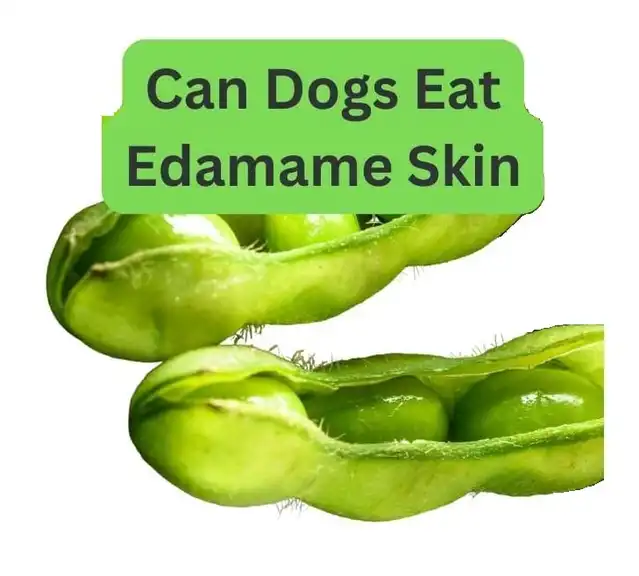Unveiling the mysterious world of canine diets, we address a question dog owners often ponder: Can dogs eat edamame skin? This comprehensive analysis delves into the intricacies of this complex topic.
Can Dogs Safely Eat Edamame Skin? Experts Weigh In
It’s not recommended due to potential digestion issues and choking risks. Always consult your vet before introducing new foods into your dog’s diet.
Understanding Edamame

Scientifically known as Glycine max, it is an immature soybean harvested before it hardens, native to East Asia. A staple in Asian cuisine, edamame has gained popularity worldwide for its versatile culinary applications and rich nutritional content. Edamame is typically green and encased in a protective pod that houses two to three individual beans. The edamame’s skin, the outer layer of the bean itself, is slightly tough and fibrous.
According to the United States Department of Agriculture (USDA), edamame is packed with essential nutrients, including proteins, dietary fiber, vitamins, and minerals, particularly folate, vitamin K, manganese, and copper. It’s also a good source of health-enhancing isoflavones and saponins.
However, regarding canine consumption, dogs’ dietary needs and digestion capabilities differ significantly from humans. Dr. Jerry Klein, Chief Veterinary Officer at the American Kennel Club (AKC), points out that dogs descending from wolves have a digestive system primarily developed for a meat-eating diet, albeit with some adaptability to an omnivorous diet. Therefore, not all human foods are appropriate for dogs.
As per Dr. Klein’s advice, knowing which ones are secure is important, while dogs can eat certain fruits and vegetables. Some plant-based foods can be harmful or even deadly to dogs due to the presence of toxic compounds. Therefore, it’s recommended to always consult with a veterinarian before introducing a new food, such as edamame, into your dog’s diet (2).
Despite being non-toxic, edamame skin can be difficult for canines to digest and may pose a choking hazard, making it generally not recommended for canines.
Anatomy of Edamame: The Skin
Edamame, the young soybean, comprises a few essential parts – the pod, the beans, and the bean’s skin. Our focus here is the skin, the outermost layer of the bean itself.
The skin is thin and slightly tough, with a somewhat fibrous texture. In culinary applications, humans eat it due to its nutrient richness, such as fiber. However, the situation is different when it comes to dogs.
Veterinary experts, including Dr. Klein from the American Kennel Club, have explained that while dogs have evolved to tolerate a wider variety of food, their digestive systems are primarily designed for digesting meat (1). Foods that are more fibrous and tough can be challenging for a dog to digest, potentially leading to discomfort or gastrointestinal issues.
It is where the skin of the edamame comes into the picture. The texture and fibrous nature of the edamame skin can be hard for dogs to break down and digest, which may result in gastric irritation. In severe cases, it might even cause blockages in their digestive system. Moreover, the size and shape of edamame skins could pose a choking risk, particularly in smaller dogs or dogs that gulp their food without thoroughly chewing it.
While there’s no denying that edamame beans have nutritional benefits, such as being high in protein and fiber, their skin might pose risks that outweigh the potential nutritional gains for our canine companions.
Chemical Constituents of Edamame Skin

Edamame, including its skin, is rich in numerous nutrients and bioactive compounds, making it a healthy choice for humans. The skin of the edamame bean, although somewhat tough and fibrous, is where much of the plant’s nutritional value is concentrated.
Protein and Fiber
Edamame is a good source of plant-based protein primarily contained within the bean. The skin also contributes to edamame’s dietary fiber content, which aids digestion and helps maintain a healthy weight in humans.
Vitamins and Minerals
Edamame contains several vitamins and minerals, particularly vitamin K, folate, manganese, and copper. Some of these nutrients are found in the skin.
Phytochemicals
The skin of the edamame bean contains phytochemicals like isoflavones and saponins, which are plant compounds with potential health benefits. Isoflavones are a type of plant estrogen (phytoestrogen) and have antioxidant properties, while saponins have been studied for their potential role in heart health and immune function.
Polyphenols
Edamame skin is rich in polyphenols, specifically anthocyanins, which give the skins of some edamame varieties their black or purple color. Polyphenols have antioxidant properties and may offer a variety of health benefits.
While these constituents contribute to the nutritional value of edamame for human diets, it’s essential to remember that dogs have different dietary requirements and digestive capabilities. The high fiber content and tough texture of edamame skin can make it difficult for dogs to digest, potentially leading to gastrointestinal distress. Always consult a veterinarian before introducing new foods into your dog’s diet.
Understanding Canine Digestion
Canines possess a digestive system distinct from ours. Their carnivorous ancestry has equipped them with a system optimized for meat digestion while less efficient at breaking down certain plant materials.
Can Dogs Digest Edamame Skin?
While dogs have a certain level of adaptability regarding their diet, their digestive systems are primarily designed to handle a carnivorous diet. It means their ability to process plant matter, especially tougher, fibrous materials like edamame skin, is limited compared to humans.
Edamame skin is rather tough and fibrous. This texture can be difficult for a dog’s digestive system to break down, potentially leading to various issues. Undigested pieces of edamame skin may cause gastrointestinal upset, including symptoms like vomiting, diarrhea, or constipation.
If the edamame skin isn’t thoroughly chewed before swallowing, it could cause blockages in a dog’s digestive tract. This risk is especially significant for smaller dogs or dogs that eat quickly without properly chewing their food.
While a dog’s digestive system can technically process edamame skin, it is not ideally suited to handle this type of material. The potential risks associated with feeding dogs edamame skin typically outweigh any possible nutritional benefits, so many veterinarians recommend avoiding it in a dog’s diet. As always, your dog’s diet changes should be discussed with your veterinarian.
Possible Risks of Feeding Dogs Edamame Skin

It’s important to consider these possible hazards before feeding your dog edamame skin.
Digestive Issues
The first and perhaps most prominent risk is digestive complications. The fibrous nature of edamame skin can be difficult for dogs to digest, potentially leading to gastrointestinal upset, including symptoms like vomiting, diarrhea, or constipation.
Choking Hazards
Edamame skin also presents a potential choking hazard, particularly for smaller dogs or those that gulp food without thoroughly chewing:
- Choking Risk: Dogs, especially smaller breeds, may try to swallow pieces of edamame skin whole, which could block their airway and cause choking.
- Esophageal Blockage: Even if the edamame skin does not fully block the airway, it can become lodged in the esophagus, causing discomfort and potential damage.
Blockages
If not properly chewed, larger pieces of edamame skin could cause blockages in the esophagus, stomach, or intestines, requiring immediate veterinary attention.
Allergic Reactions
As with any food, there is always a risk of an allergic reaction. While food allergies are not exceedingly common in dogs, they can occur. Signs of an allergic reaction can range from skin irritations (itching, redness, swelling) to gastrointestinal symptoms like vomiting or diarrhea and, in rare cases, more severe reactions such as difficulty breathing.
Nutrient Imbalance
Dogs have specific dietary requirements that are different from humans. While edamame is nutritionally dense for humans, feeding dogs too much could lead to a nutrient imbalance in their diet.
Gastrointestinal Issues
Edamame skin’s fibrous and tough texture can make it challenging for dogs to digest. It can result in a variety of gastrointestinal issues:
- Indigestion: Edamame skin may not break down adequately during digestion. It can lead to discomfort, bloating, and flatulence in your pet.
- Vomiting or Diarrhea: If the edamame skin irritates the digestive tract, it may cause vomiting or diarrhea as the body attempts to expel the irritating substance.
- Gastrointestinal Blockage: In severe cases, if a significant amount of edamame skin is consumed and it’s not properly broken down, it may lead to a gastrointestinal blockage. It is a serious condition that can cause severe abdominal pain, vomiting, and lack of appetite and could require surgical intervention.
Always remember that each dog is an individual and may react differently to different foods. If you decide to feed your dog edamame skin, start with a small amount and monitor your dog for any adverse reactions. Stop feeding Edamame at the first sign of distress and consult with your veterinarian. Dogs should primarily be fed high-quality commercial dog food or a balanced homemade diet under veterinary supervision for optimal health.
Veterinary Opinions on Dogs Eating Edamame Skin

While edamame skin is not inherently toxic to dogs, many veterinarians still express concern over feeding it to our canine companions. The primary concerns stem from its potential to cause digestive upset, its tough texture, which can lead to choking, and the risk of blockages if not properly chewed.
Dr. Jennifer Coates, a veterinary advisor with petMD, emphasizes the importance of cautious feeding habits for dogs. She suggests that while dogs have adapted to a more omnivorous diet over time, their primary source of nutrition should still be animal-based, as this is what their bodies are primarily designed to digest and utilize (1).
Moreover, Dr. Gary Richter, a veterinary health expert with Rover.com, points out that new foods should be introduced gradually to monitor for adverse effects. Regarding edamame, he emphasizes that while the beans themselves can be a healthy treat when given in moderation, the skins could be harder to digest and should generally be avoided (2).
While it’s not a universal consensus, the general veterinary advice leans towards caution regarding dogs and edamame skin. As always, each dog’s health and diet should be discussed with a trusted veterinarian to address the pet’s individual needs.
Alternatives to Edamame for Dogs
Ensuring your dog receives the necessary nutrients in their diet is crucial. If you’re considering edamame for its health benefits but are wary of the potential risks associated with the skin, there are numerous safer alternatives that you can introduce into your dog’s diet.
Carrots: A classic dog choice, carrots are rich in vitamin A, fiber, and other essential nutrients. They can be served raw for a healthy, crunchy snack or cooked if your dog prefers.
Sweet Potatoes: High in dietary fiber, vitamins A and C, and antioxidants, sweet potatoes can be a great addition to your dog’s diet. To prevent choking, cook them thoroughly and serve them in small, manageable portions.
Green Beans: Low in calories and packed with beneficial nutrients such as vitamins C, K, and manganese, green beans can be a healthy dog treat. They can be served cooked or raw, but always without any seasonings.
Pumpkin: Particularly beneficial for dogs with digestive issues, pumpkin is high in fiber and vitamin A. It’s usually served cooked and mashed.
Peas: Another excellent alternative, peas are high in vitamins A, K, and B, along with numerous minerals. Frozen peas can make a refreshing treat for your dog on a hot day.
Cucumbers: Cucumbers can be given to dogs in moderation as a hydrating and low-calorie treat. They are particularly beneficial for overweight dogs.
As with any dietary changes, these foods should be introduced gradually and under the guidance of a veterinarian. Monitor your pet for any adverse reactions when introducing these foods and, if observed, discontinue feeding them and consult with your veterinarian. It’s important to remember that while these foods can contribute positively to a dog’s diet, they should not replace a balanced, high-quality dog food that ensures they’re receiving all the nutrients they require.
Potential Benefits of Edamame for Dogs
Despite the risks associated with edamame skin, the beans can allow dogs when properly prepared and restrained.
- High in Protein: beans are rich in plant-based protein. While dogs primarily need animal-based proteins, plant proteins can be a supplemental source in their diet.
- Nutrient-Rich: it is packed with essential vitamins and minerals, including Vitamin K, folate, and manganese, which can donate to your dog’s overall health.
- Fiber Source: It contains a good amount of dietary fiber, aiding digestion and controlling a dog’s weight.
Alternative Ways to Incorporate Edamame into a Dog’s Diet:
It’s important to do so safely, focusing on the beans and not the skin.
- Boiled Edamame: Boiling is a simple and safe method to prepare it for your dog. Just remember to remove the beans from the pods.
- Pureed Edamame: It can create them easier for your canine to consume and digest. You can add pureed edamame to your dog’s regular food as a nutrient boost.
- Edamame as a Treat: It can be frozen and given as a refreshing treat on a hot day. Ensure the beans are thoroughly cleaned before freezing.
Any modifications to your dog’s diet should be introduced gradually and under the guidance of a veterinarian. While edamame can offer some nutritional benefits, it should always supplement a complete and balanced dog food. Treats, including those made from edamame, should comprise at most 10% of a dog’s daily caloric intake.
The Importance of Balanced Nutrition and the Role of Commercial Dog Food
Dogs have specific dietary needs that differ from those of humans. Their diet must precisely balance proteins, carbohydrates, fats, vitamins, and minerals to ensure their bodies function properly.
- Commercial Dog Food: they are generally prepared to provide a proportional diet for dogs. These foods are prepared to complete the (AAFCO) ‘s health standards, ensuring they have all the vital nutrients a dog requires for general health and care. These products come in various forms, including dry kibble, canned wet food, and semi-moist options, each with benefits.
- Veterinarian-Approved Homemade Diet: Some pet owners prefer to feed their dogs a homemade diet. While this can allow for greater control over your dog’s eating, consulting with a veterinarian or a pet nutritionist is vital to confirm the diet is proportional and complete. Homemade diets that are not properly balanced can guide to nutritional deficits or lots, which can harm your dog’s health.
It should serve as your dog’s primary source of nutrition. Supplementary foods, including edamame or other ‘human’ foods, should constitute only a small portion of their total caloric intake. These foods should be considered treats and should never exceed 10% of the dog’s daily caloric intake.
It supports your dog’s general health and resistance system, encourages healthy skin, aids digestion, supports bone and dental health, and can help control diet-related diseases. Every dog is unique, and their health needs will count on their species, age, size, exercise level, and general health status. Always consult with a veterinarian for the most proper diet for your pet.
Conclusion
Can Dogs Eat Edamame Skin – While edamame is nutritionally rich, the skin might pose potential risks for dogs. The pet owner’s discretion, guided by veterinary advice, is crucial in determining whether to include edamame skin in a dog’s diet.
Extensively explores the impact of edamame skin on a dog’s diet and health. The findings suggest that despite edamame’s beneficial nutrients for humans, such as proteins, dietary fiber, vitamins, and minerals, the skin of edamame can pose certain challenges for dogs.
Given that canines have evolved primarily to digest a meat-based diet, tougher and fibrous food materials like edamame skin could lead to digestive discomfort, choking hazards, or even blockages in the digestive system.
Therefore, it is generally not recommended to feed dogs edamame skin. Instead, safer alternatives such as carrots, sweet potatoes, green beans, pumpkin, peas, or cucumbers could be introduced to the dog’s diet under the guidance of a veterinarian.
Moreover, it’s crucial to maintain a balanced diet primarily comprising high-quality commercial dog food or a balanced homemade diet, ensuring all essential nutrients required for a dog’s optimal health.



